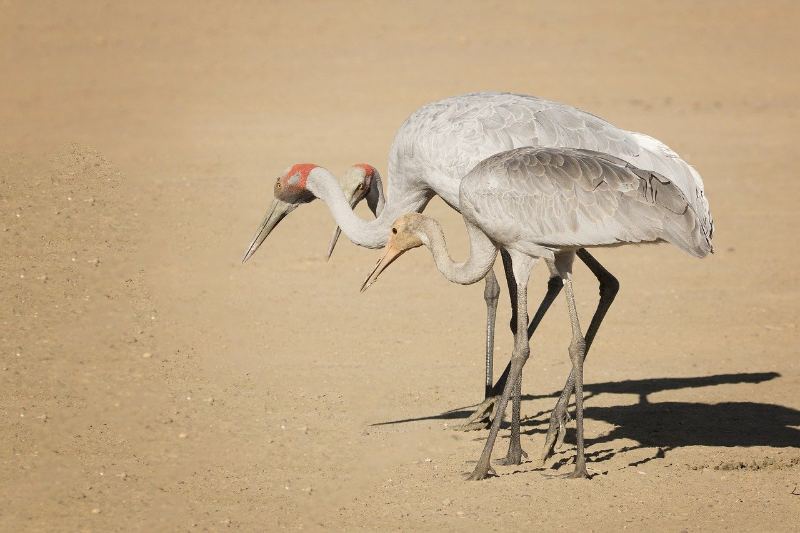How do you explain the characteristics of the birds is its color, height, or beak?
But most interesting is the long leg of the bird that makes you think twice or thrice perhaps even longer than the usual when you are interested in their long legs.
Table of Contents
Birds With Long Legs
1 Secretary Bird (Sagittarius serpentarius)

The secretary bird is a terrestrial bird of prey belonging to Africa that belongs to vulnerable birds. Which have a lifespan of maximum of 15 years and can fly but prefers to stay on ground.
Identification: They can grow up to 1.2 to 1.5 m, have a wingspan of 2m and can reach a weight of 4 kg.
Foods: The foods of these birds are rodents such as mice, small mammals and vertebrates, grasshoppers, frogs and lizards.
Facts: Did you know Secretary birds are called “devil’s horse.” because of its running speed and can travel 30 km per day.
The nests are built by both male and female birds on an acacia tree, and the same nest can be used for many years. The eggs laid by females are 2-3 in number and blue to green in color and are incubated by both parents.
2. American Bittern (Botarus lentiginosus)

The American Bittern shows camouflage so it is harder to spot in freshwater marsh areas so the researchers use recorded calls of the American bittern to attract and catch them. Habitat: Their habitats include freshwater marshes, wetlands, coast, brackish marshes, and dry grasslands.
Identification: The weight of these bitterns are around 600 grams with length 30-45 inches. Thus, the adult American bitterns are large, and have yellow eyes with rich brown parts, and a white throat. The sexes are similar in appearance therefore sometimes harder to differentiate between the male and female bitterns.
Food: The food of American Bittern includes Dragonflies, amphibians, snakes, and water insects such as giant water bugs.
Facts: They give calls like clacking, gulping calls that sound like water running in pipe and old water motor pumps, so, for this reason, they are given nicknames, including “stake-driver,” “thunder-pumper,”, “mire-drum” and “water-belcher.”
3. Flamingo (Phoenicopterus roseus)

The bird with not only long legs but also with a long neck and body is the flamingo, the greater flamingo that is widely distributed across Africa, India and southern europe.
Habitat: shallows of salt, brackish water, estuaries and alkaline lakes.
Identification: The height of flamingos is around 1-1.5 m which can weigh around 4kg.
Food: The foods of Flamingo range from fishes to Blue-green and red algae, crustaceans, and molluscs.
Facts: Hunting and eating flamingos is illegal in the U.S and as well as in many other countries.
4. Great Egret (Ardea alba)

Like most birds with long legs the great egret also has long legs as they live in marshy areas. These belong to the Ardeidae family.
Habitat: They live in marshy areas such as freshwater, brackish, marine wetlands, lakes, ponds, marshes, estuaries, islands, swamps, streams, rivers, lagoons, tidal flats, canals, ditches, fish-rearing ponds, and flooded farm fields.
Food: They feed on such as small fish, amphibians, reptiles, invertebrates like crayfish, prawns, dragonflies, giant water bugs, grasshoppers, damselflies, whirligig beetles, and shrimp.
Identification: The length of Great egrets is 33 to 40 inches tall with a wingspan of 59 inch. Weight of the Great egrets is about 900 to 1,360 gm. During the breeding season, a part of the feather on its face turns neon green in color, while long plumes appear at its back.
Facts: The Great egret is found to be aggressive. In these bird’s nestlings, we can see siblicide that is where large chicks kill their smaller sibling chicks. The Siblicide trait is also present in some birds of prey like eagle, hawks, and owls. Siblicide occurs because of an improper breeding environment and parents fail to supply sufficient foods on time regularly.
5. Black-Necked Stilt (Himantopus mexicanus)

This shorebird has long legs that are slender like and are distributed across the American wetlands and coastlines. Habitat: Its habitats include shallow wetlands, salt ponds, flooded areas of rivers, shallow lagoons, saltmarshes, mangrove swamps, mudflats, Sewage ponds, evaporation ponds, rice fields, and flooded agricultural fields.
Identification: The height and weight are around 14 to 17 inches and 190 gm respectively with a diverse food in its diets. The ventral body has white color feathers and dorsal has black colored feathers with red colored long legs and has records of lifespan of up to 20 years.
Food: They feed on insects, beetles, flies, shrimps, snails, and aquatic plants too. These birds have an ideal body meant for wading in shallow waters while prey for food at seashore and rivers as well.
Fact: Both male and female birds of Black-necked stilt participate during the incubation period.
6. Great Blue Heron (Ardea herodias)

The Great Blue Herons are capable of hunting both day and night. Its special neck vertebrae help to strike the prey at a distance. Habitat: Their habitats include both freshwater and saltwater habitats, grasslands, agricultural fields, and isolated swamps.
Identification: The weight Great Blue Herons are around 2-2.5 kg with a length 3-4 feet with a wingspan around 5-6 feet that is quite comparable with their heights.
Food: They capture a variety of prey such as fish, amphibians, small mammals, insects, and reptiles. Their long legs enable them to prey on the prey that are away as these are visible easily for these birds than those of short legged birds.A study says that the Great Blue Herons eat diseased fish at fish hatcheries thus enables the fish hatcheries safer from spreading diseases.
Facts: Did you know both the male and female of Great Blue Herons participate in building nests? Yes, it’s true and unbelievable where Male Great Blue Herons collect nest material, such as sticks, shrubs, and tree litters, and present them to the female.
7. Australian Crane (Grus rubicunda)

The brolga is a bird that belongs to the crane family and is also known as Australian crane.
Habitat: Its habitats include open wetlands, coastal mudflats, irrigated croplands, estuaries and mangrove creeks.
Identification: They weigh about 6.2 kg with wingspan up to 2.4 meters. These are birds identified by a tall body, a large beak, a long neck, whose cheeks, and throat pouch don’t have feathers. Both male and female are similar in appearance.
Food: As it belongs to omnivores, it can eat both plant and animal derivatives such as wetland plants, insects and amphibians, fishes and sometimes rodents or mice.
Facts: These brolga birds can dig holes using their beaks or bills in the muds in order to find the tubers. On the heads of cranes there is at least one patch of unfathered skin present while in herons it’s not.
8. Green Heron (Butorides virescens)

Green herons are known for tool-using bird species, that is it drops bread crusts and insects on the surface of the water to attract fishes. During winters these Green herons live on the west coast and in the Southern United States along rivers, oceans, lakes, and ponds. Habitats: The Green heron is found in coastal, swamps, marshes, lakes, ponds, and inland wetlands during breeding.
Identification: The length and weight are around 15-18 inches and 250gms respectively. It has a short body, short legs, rounded wings and a long, and a dagger-like bill.
Food: The food of these birds are small fish such as minnows, sunfish, catfish, pickerel, carp, perch, shad, eels, and goldfish, Insects, such as spiders, crustaceans, and snails.
Facts: The male builds nests before it finds a mate, later it passes nests to its mate. They are sometimes found to attract fishes by giving them insects and small fishes as bait.
9. Cassowaries (casuarius)

The Cassowary found in tropical forests of New Guinea, Maluku Islands, and Australia. These are flightless birds with stronger long legs that are advantages for them since they impart speed to these birds on terrestrial and also enable them to jump around 7 feet.
Habitat: Its habitats include tropical rainforests, melaleuca, paperbark, swamps, mangrove forests, woodlands, and beach sides.
Identification: These adult birds are 1.7 m tall which can weigh around 44 kg. These are big birds that have tall brown casque that is a helmet on their head, blue and purple neck, black glossy plumage.
Food: The source of foods includes both plant and animal based such as fungi, flowers, fruits, frogs, snails, insects, birds, fish, rats, mice, and carrion.
Facts: They can attack animals including humans and can cause severe injuries.
10. Cattle Egret (Bubulcus ibis)

The location of these Cattle egrets is found to be north and south America. They are sometimes found on the back and near the grazing cattle, where it captures its prey such as ticks on the cattle and grass insects. Habitat: They live in marshes, lakes, swamps, riverside woodlands, and reservoirs.
Identification: Theyare 20-20 inches in length which weighs around 220 grams. They have relatively short legs, a short neck, straight bill and rounded wings.
Food: These Cattle egrets feed mainly on insects, invertebrates, fish, frogs, mammals, and birds such as warbles.
Facts: The local names of Cattle egret are cow cranes, cow herons, rhinoceros egrets, and hippopotamus egrets, and cowbirds.
11. Emu (Dromaius novaehollandiae)

This bird does not only have long legs but also a big body too, therefore Emus are considered as the second largest bird in the world after the ostrich. Habitat: Their habitat includes open plains, snowfields, forests, savannah woodlands, and rainforests.
Identification: The height is around 1.75 m and weight are approximately 40 kg. These are large birds that can’t fly like other bids. Its size is comparable to the ostrich.
Food: The foods range from plants to animals such as seeds, flowers, fruits and tender roots and in animals’ insects, caterpillars, beetles, grasshoppers, small vertebrates. which suggests that they are omnivorous that supports its big body and long and thick legs.
Facts: The emu has two sets of eyelids, one eyelid meant for blinking and the other eyelid meant for keeping dust away!
12. Snowy Egret (Egretta thula)

The Snowy egret is found in California, Arizona, Mexico and Virginia. Habitat: Its habitats include salt marsh islands, swamps, marshes, estuaries, saltmarshes, tidal channels, shallow bays, mangroves, saltwater lagoons, freshwater swamps, grassy ponds, shallow reefs, and wet fields.
Identification: The Snowy egret is 24 inches and weighs around 270 gms. They have a white feathered body, with black legs, yellow feet. During the breeding season their foot changes in color, while Snowy Egrets grow filmy, curving plumes, that make them an endangered species.
Food: They feed on aquatic animals, fish, insects, crustaceans, crabs, crayfish, frogs, snakes, snails, worms, lizards, rodents. and insects.
Facts: The famous names of it are “lesser egret”, “little egret”, “little snowy”, “little white egret” and “little white heron.”
13. Black Stork (Ciconia nigra)

The black stork is a large bird that belongs to the stork family called Ciconiidae. Habitat:Black stork is found at ponds, estuaries, lakes and rivers.
Identification: These have blacker feathers on the dorsal surface of the body and less white feathered ventral body with both red colored beaks and legs.
Food: They feed on aquatic animals, crabs, amphibians, snails and fishes and also molluscs, earthworms, and insects such as beetles.
Facts: The black storks kill their own baby storks, during bad weather, foods supply is limited or not available enough to feed all the stork babies, so parent will kill the weakest baby to divert the foods at least to the remaining nestling babies of storks or simply in a nest, they will reduce the number of storks so that they can increase the food supply to small number of baby storks in nest.
14.Tricolored Heron (Egretta tricolor)

The Tricolored Heron found in New Mexico and Texas of the U.S during breeding seasons and in winters in northern South America as well. Habitat: They thrive in fresh and saltwater; along marshes, swamps, ponds, shores, coastal areas.
Identification: The Tricolored heron is more colorful during the breeding season because its bill turns into bright blue with a black tip, neck feather turns into bluish-purple, its legs become pink and shoulder plumage turns violet in color. They can reach around 10-12 inches in length and weigh about 310gms.
Food: The diet of Tricolored Heron are small fish, crustaceans such as crayfish, prawns, aquatic insects and grasshoppers, tadpoles, and lizards.
Facts: The Tricolored heron camouflages itself by standing straight with its bill pointed up to the sky. When finding prey, these Tricolored herons found to go deeper inside the water than the other types of herons.
15. Common Ostrich (Struthio camelus)

The next bird is the world’s largest bird which also has long legs is an ostrich bird which is a flightless bird which are found mostly in open lands of Africa. Habitat: They live in open arid, semi-arid, savannas and Sahel.
Identification: Its height is around 2-2.8 m with a wingspan of 2 m and weighs about 100 kg.
Food: The foods of ostrich birds are plants, roots, and seeds and insects, lizards that mean it is an omnivorous bird.
Facts: Ostriches have three stomachs that aid them metabolize the hard plant matter that a single stomach is unable to manage, therefore they have three stomachs to make its digestion process easy.
An ostrich kicks from the strong and long legs produce stronger forces that is enough to kill the other animals such as the lion.
16. Purple Gallinule (Porphyrio martinicus)

The Purple Gallinule is found in the Florida peninsula and also breeds along the coasts of the southern states. During winter it migrates to southside and Central America where wetlands and swamps are available.
Habitat: Its habitat includes freshwater marshes, aquatic vegetation, lakes, ponds, impoundments, reservoirs, wet rice fields, wetlands, barrier island beaches, and gardens.
Identification: The Length of the Purple gallinule is about 12-15 inches and weighs around 250gms. They have a shaped bill, short tail, long legs and toes, along with a purple-colored body, greenish wings and back, yellow legs and feet.
Food: The foods of Purple Gallinules include snails, dragonflies, leeches, spiders, beetles, bees, worms, ants, grasshoppers, and moth larvae, as well as frogs, and small fish.
Facts: Purple Gallinules are omnivores, that is it can eat plants and animals. Therefore, its diet includes eating flowers, leaves, seeds and tubers and aquatic and terrestrial animals.
17.American Avocet (Recurvirostra americana)

The American Avocet in breeding seasons are located at Dakotas, New Mexico, coast of California and Texas. Habitat: It is found in shallow water or mud flats, shallow fresh, saltwater wetlands, salt ponds, evaporation ponds, mudflats, tidal lagoons, brackish impoundments, sewage ponds, rice fields, and flooded pastures.
Identification: They are around 18-20 inches tall with wingspan approximately 27-20 inches and weigh 340 g. They have a long and upturned bill, a long neck, and a round head.
Food: They feed on crustacean and aquatic insect prey.
Fact: American avocets commonly produce only one brood per season. The chicks of American avocets are so advanced that they usually leave the nest within a day after hatching.
Read More : Symbolism Of Birds !
18. Scavenger Stork (Leptoptilos crumenifer)

A Scavenger Stork are the very large tropical storks that belongs to the family Ciconiidaean are found in south Africa and Sahara. Habitat: They live in open dry savannas, grasslands, swamps, riverbanks, and lake shores.
Identification: They are 60 inches tall with a wingspan 3 m and weigh around 8 kg so now you could imagine how large they are.
Food: The foods of these birds are termites, locusts and dead animals such as humans, flamingo, frogs, rodents, snakes, and even dead elephants.
Facts: Marabou stork can eat 2 pounds in a swallow. The average lifespan in the wild is 25 years while maximum lifespan recorded is up to 41 years in captivity.
19.African Jacana (Actophilornis africanus)

African jacana is a one type of jacana bird in Africa out of many types of jacanas, it is a wading bird. Habitat: floating vegetation in shallow lakes, river, and pond.
Identification: This can be identified by long toes and long claws. It weighs 1.4 to 2.6 kg and 30 cm tall; these features allow it to stand and walk on the floating vegetation of lakes. Other names include ‘Jesus’ bird’, ‘lily trotter’, and ‘lotus bird’
Food: The foods insects, mollusks, and aquatic seeds and animals.
Facts: This bird’s toes are longer than most other birds and they are so because those longer toes enable them to stand on floating vegetation.
20. Owls

You are left with surprise when we list the owls in the long-legged bird’s category. Owls are the nocturnal creatures that are widely distributed across the world. Habitat: coniferous forests, mountains, deserts, plains, and cold tundra
Identification: The owls almost all types of owls have comparatively long legs that are not visible as these legs are hidden in their lower body feathers.
Snowy owl or polar owl, white owl and Arctic owl is around 2 kg in weight, and 63 – 73 cm in length. Whereas the Barn owl or Tyto alba is around 620 gm in weight and 40 cm in length.
Food: They feed on rodents, small mammals, frogs, lizards, mice, snakes, aquatic animals mostly fish, rabbits, birds, and squirrels. These foods suggest that they are carnivores.
Facts: Owls spend much of their waking time hunting for food. Many owl species are carnivores, or meat eaters.
